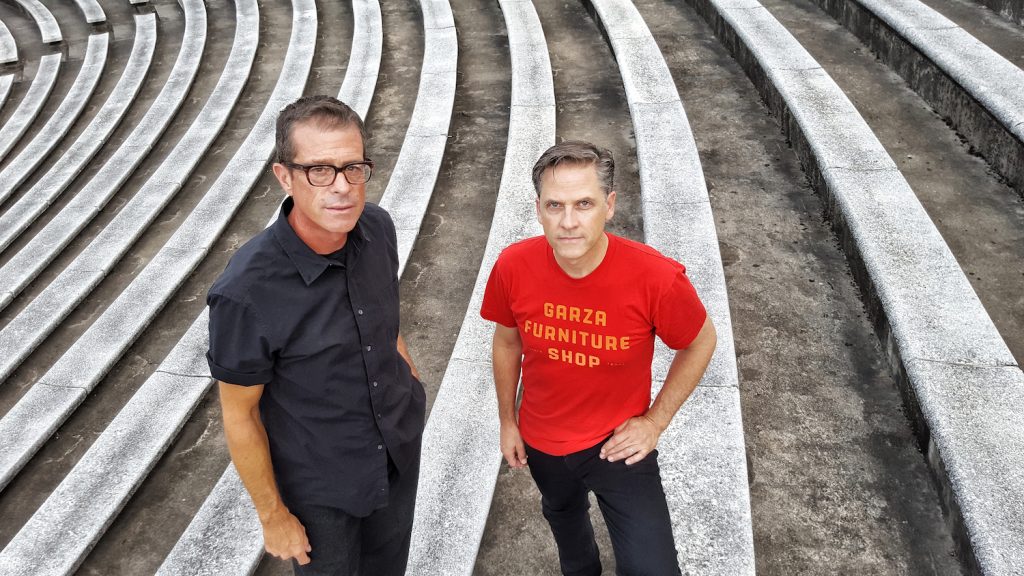
The multinational Calexico expands musically while still exploring the ties that bind us all
Calexico has always been about crossing borders. If there’s ever been a band that doesn’t love a wall, it’s Calexico, whose name comes from a town on the U.S. side of the Mexican border (across from its inverse hybrid Mexicali). In its current incarnation, the Tucson-based outfit led by Joey Burns and John Convertino includes members from Germany, Spain, New York City, El Paso and Nashville: Calexico relishes cultural crossings. Although Burns and Convertino started off in 1995 mining Southwestern-flavored Americana and indie rock, they evolved to more deeply explore the musics and characters of the Mexican-American border, sometimes leaning more to gentle mariachi horns, sometimes to more traditional rootsy rock. They’re consistent but unpredictable.
“It’s hard to know how we do what we do,” says Burns. “I’m going by my gut; I’m looking for a feel. We’re not the kind of band to repeat ourselves. I can see how other listeners would be like, ‘Eh, I don’t get it.’ Maybe there’s too much subtlety or too much of a mix of styles of music. It’s not easily defined. I totally get it when I read a review or talk to listeners and they say, ‘I like your early stuff.’ But we have to do this. This is who we are right now.”
Who they are right now is evident on The Thread That Keeps Us (Anti-), their ninth studio album. It’s many things: It tells stories of characters struggling with “love in the age of extremes” and with a looming apocalypse; it blends subtle melodies with noisy electric guitars; it engages with topical political and environmental issues.
“I think now, because of where we’re at socially and politically, and because it feels like we’re stepping back, and because of economic crises, and because of war-torn areas with refugees who are being blamed for a lot, those themes resonate with us,” says Burns. “The sense of ‘home’ and what does it mean to be from Arizona today, or from California, or from the United States, or to be from North America. Those things started to weave their way into the music and the lyrics. I want to connect with people. That feeling is embedded in these songs, really wanting to connect. The best way I could do that is find some characters and get them talking and follow where their paths led.”
Although Burns writes most of the lyrics, he talks them out with Convertino—he credits Convertino with “steering the ship” of the songs, and not only from behind the drumkit—and their concerns about the state of the world and the environment ended up embedded throughout. They recorded the album in northern California, where they first met more than 30 years ago, and the studio was “in the shadow” of Mt. Tamalpais near the Muir Woods National Monument. The natural beauty around them became a focus. Or, more precisely, the threatened natural beauty. “What part of nature can you honestly say/Is beyond your explanations for short-term gain,” Burns sings on “Girl In The Forest,” a song that also alludes explicitly to naturalist John Muir.
These concerns aren’t new for Calexico, but they’re more prominent, urgent and timely. “Out here in the West, there’s so much open country and it seems limitless,” says Burns. “And yet, it’s really precious. Growing up in the West, I’ve always been concerned about pollution and our natural resources; those things have been in our arsenal of topics that we’ve written about. But there’s so much going on in our world I kinda wanted to embed the lyrics with some of those concerns.”
That sense of brewing turmoil is embedded in the music, too. The guitars—mostly from Burns and Jairo Zavala—are often dissonant or edgy, although they’re sometimes muted in the mix. Zavala adds a Robert Fripp-like solo to “End Of The World With You”; feedback courses through the ominous “Eyes Wide Awake”; a garage-rock crunch propels the sinister “Dead In The Water.”
“That noise has been missing, I think, in the last few albums,” says Burns, who’s looking forward to amping up the guitars when the band tours. “It’s reflective of what we’re feeling these days, and also lyrically.”
The album doesn’t stay in one place for long. It has rock songs, Spanish folk songs and cinematic instrumentals. The insistent, trance-like groove of “Another Space” recalls Talking Heads circa Remain In Light. (Burns says one of his favorite songs to cover when he was in high school was “Crosseyed And Painless.”) Some songs start in one place and end in another, like “Thrown To The Wild,” which gradually succumbs to a dense cacophony. Says Burns, “I love the way the second half of the song opens up to this instrumental sea of chaos. There’s trumpet a la Miles Davis, there’s noises and this chorus of oohs that’s together despite the storm and chaos. The harmony is still there, but it’s getting drowned out by the noise and chaos.”
That song almost ended the album, but Burns chose to conclude with a stronger sense of hope, with lovely acoustic ballad “Music Box.”
“I’m 51 years old right now, my kids are six years old; I want to leave a little something personal,” he says. “For me, it was probably the most punk-rock thing I’ve done in a long time, which is to write a direct love song to my kids and my wife. I usually obscure my lyrics into characters and narratives and things. It felt really good putting it straight on the line.”
—Steve Klinge





